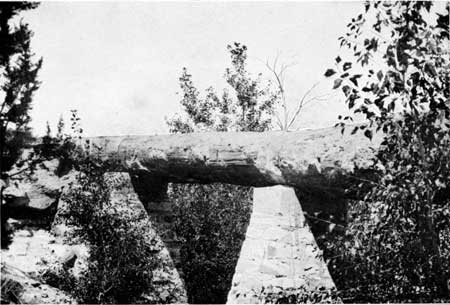.gif)
MENU
| National Parks Portfolio |

|
National Monuments

THE PETRIFIED FOREST OF ARIZONA
THE Petrified Forest National Monument lies in the area between the Little Colorado River and the Rio Puerco, fifteen miles east of their junction. This area is of interest because of the abundance of petrified coniferous trees. It has exceptional scenic features also.
The trees lie scattered about in great profusion; none, however, stands erect in its original place of growth, as in the Yellowstone National Park.
The trees probably at one time grew beside an inland sea; after falling they became water-logged, and during decomposition the cell structure of the wood was entirely replaced by silica from sandstone in the surrounding land.
SITKA NATIONAL MONUMENT, ALASKA
THIS monument reservation is situated about a mile from the steamboat landing at Sitka, Alaska. Upon this ground was located formerly the village of a warlike tribe—the Kik-Siti Indians—where the Russians under Baranoff in 1802 fought and won the "decisive battle of Alaska" against the Indians and effected the lodgment that offset the then active attempts of Great Britain to possess this part of the country. The Russian title thus acquired to the Alexander Archipelago was later transferred to the United States.
A celebrated "witch tree" of the natives and sixteen totem poles, several of which are examples of the best work of the savage genealogists of the Alaska clans, stand sentrylike along the beach.
AZTEC RUIN NATIONAL MONUMENT
AZTEC RUIN, the principal feature of this New Mexico monument, is a large E-shaped structure of pueblo type containing approximately five hundred rooms. The first story of the building is standing, and portions of the second and third stories. The ceilings are supported by large beams, cut and dressed with stone tools, which are interesting exhibits of work done in the Stone Age. The sandstone walls, reasonably plumb and with dressed faces, take high rank as examples of prehistoric masonry.
The plot of ground bearing the ruins was presented to the United States by the American Museum of National History through the generosity of Mr. Archer M. Huntington, one of its trustees.
SCOTTS BLUFF NATIONAL MONUMENT
THIS national monument in the State of Nebraska is rich in historic interest. Scotts Bluff, one of the highest known points in the State, was a well-known landmark on the Old Oregon Trail, and along this way passed a vast concourse of the pioneers that trailed overland on their way to settle the Willamette Valley and Puget Sound regions in Oregon and Washington, to hunt for gold in distant California, or to found the Mormon colonies of Utah. In the days of the pony express Scotts Bluff was the scene of many Indian battles. It is estimated that about the middle of the nineteenth century an average of one wagon every five minutes passed through Mitchell Pass, which is located within the boundaries of the present monument.
PIPE SPRING NATIONAL MONUMENT
PIPE SPRING, on the main road between Zion National Park and the North Rim of the Grand Canyon, forms a welcome oasis in the Arizona desert. This spring was famous in the early pioneer life of Utah and Arizona. Here in the early sixties the Mormon Church established a cattle ranch, and the ruined old stone fort they erected, known as Windsor Castle, is the principal feature of the monument.
YUCCA HOUSE NATIONAL MONUMENT
THIS monument was established to preserve the ruin of a prehistoric village in southwestern Colorado. The village is now a cluster of mounds with no sign of a wall rising above their surfaces. On account of the large size and extent of the mounds, it is believed that when excavated they will prove of great archeological interest and educational value. The land upon which the ruins are situated, approximately 10 acres in extent, was donated to the United States Government by Henry Van Kleek, of Denver, Colorado.
Continued >>>
 Top
Top
Last Modified: Mon, Oct 31, 2002 10:00:00 pm PDT
http://www.cr.nps.gov/history/online_books/portfolio/portfolio11i.htm
![]()
